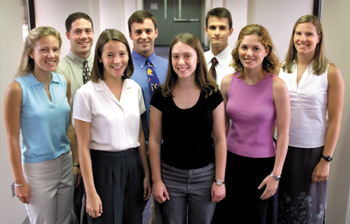
This year's Christie Scholars are (left to right): Elise Cornet, Phil Ciampa, Brett Battle, J. P. Norvell, Amanda Cooper, Jeffrey Venstrom, Andrea Legath, and Cory Vogt. (photo by Dana Johnson)
Vanderbilt receives cancer funding 46 years in a row
It was 1958 – the year the Barbie doll was introduced, Arnold Palmer won his first Masters and the hula-hoop became a national craze.
It was also the first year that Vanderbilt was awarded an Institutional Review Grant from the American Cancer Society, an award designed to help groom future cancer researchers.
Since that time, more than 200 young investigators have received funding through Vanderbilt’s IRG, which was recently renewed for the 44th-46th consecutive years of funding.
“This is the only grant on campus dedicated to young investigators,” said Dr. Lawrence J. Marnett, Mary Geddes Stahlman Chair in Cancer Research and director of basic research at the Vanderbilt-Ingram Cancer Center. “In fact, it should be an investigator’s first grant. It is intended to provide money to develop preliminary data that can be used to attract other funding.”
The grants not only help individual scientists begin to build a track record, but also benefit the broader field of cancer research, said Marnett, principal investigator of Vanderbilt’s IRG since taking the reins from Dr. John Lukens in 1993.
“It is an effective way to capture young investigators and get them interested in cancer research at a formative stage in their career,” Marnett said.
The IRGs are given to institutions. Investigators then apply directly to the institution for a share of the grant. A maximum of $20,000 can be awarded to an individual scientist.
Vanderbilt’s IRG provides $95,000 a year. In addition, the Sartain-Lanier Foundation has pledged an additional $250,000 that is being tacked onto the IRG, for the same purpose, at the rate of $50,000 per year.
About eight investigators are funded through the mechanism each year, Marnett said, encouraging any junior level faculty member with an interest in pursuing a cancer-related project to consider applying.
“Applicants do not have to be members of the Vanderbilt-Ingram Cancer Center,” he said. “And it is not limited to basic science. This grant supports clinical research, population-based research and quality-of-life research. The caliber of applicants we’ve had over time has helped us to remain competitive for funding year after year.”
Applications are solicited each spring and fall. A call for applications is published in the VUMC Reporter, in the Vanderbilt Register and on the Vanderbilt-Ingram Cancer Center’s Web site at www.vicc.org.













